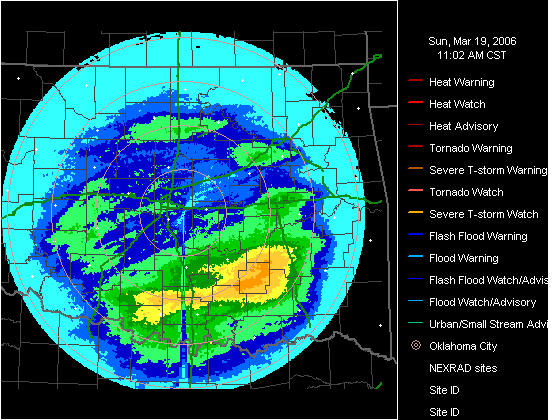Ticker for March 19, 2006
MESONET TICKER ... MESONET TICKER ... MESONET TICKER ... MESONET TICKER ...
March 19, 2006 March 19, 2006 March 19, 2006 March 19, 2006
Does this mean there's no tooth fairy, too?
Radar shares with humanity a certain charming fallibility, falling
short of its ultimate goals, yet accomplishing so much in their
pursuit. Where would humanity be if not for distant-minded dreamers
and relentless perfectionists who fell so short of their goals,
but gave us so much? Without them, we'd be without countless works
of art, science, and the Chicago Cubs.
Anyway, one of radar's nice-but-probably-unattainable goals is an
accurate estimation of rainfall. There are many problems which keep
radar from grabbing that great brass ring, or whatever machines
aspire to. One of those problems is the bright-band effect.
By some vague mystery long-forgotten by the Entire Ticker Staff (but
defined quite nicely by concerned physicists), melting precip is much
more radar-reflective than the icy crystals they recently were and
the droplets they will soon become. Because of this, radar can often
be fooled by precip amounts at the height of the melting layer.
Around here, this phenomenon shows up best in stratiform precipitation
during the cold season (much like what's probably going on outside
your window at the time of this writing). The result is a gruesomely
unnatural "donut" around the radar, which falsely depicts greater
precip amounts at a constant distance from the radar. In other words,
one might see this:

Or this:

Did Mother Nature decide to drop her heaviest rains in a donut around
these radar sites? Of course not. Taking into account the radar beam's
tilt, these distances correspond to the heights at which this very
reflective melting process is occurring (around 9000 feet during this
particular episode).
Fortunately, rain gauge data is often used to correct radar errors.
Unfortunately, corrections to rainfall data are often done crudely
and bluntly across the entire radar scope, which means that correcting
for the bright-band can mean over-correcting for everything else ...
... which is exactly the case in this event, where the radar has been
grossly over-estimating rainfall values in the bright band, and
somewhat underestimating the near-radar values.
March 19 in Mesonet History
| Record | Value | Station | Year |
|---|---|---|---|
| Maximum Temperature | 97°F | BEAV | 2017 |
| Minimum Temperature | 5°F | EVAX | 2023 |
| Maximum Rainfall | 4.46″ | PRYO | 2012 |
Mesonet records begin in 1994.
Search by Date
If you're a bit off, don't worry, because just like horseshoes, “almost” counts on the Ticker website!